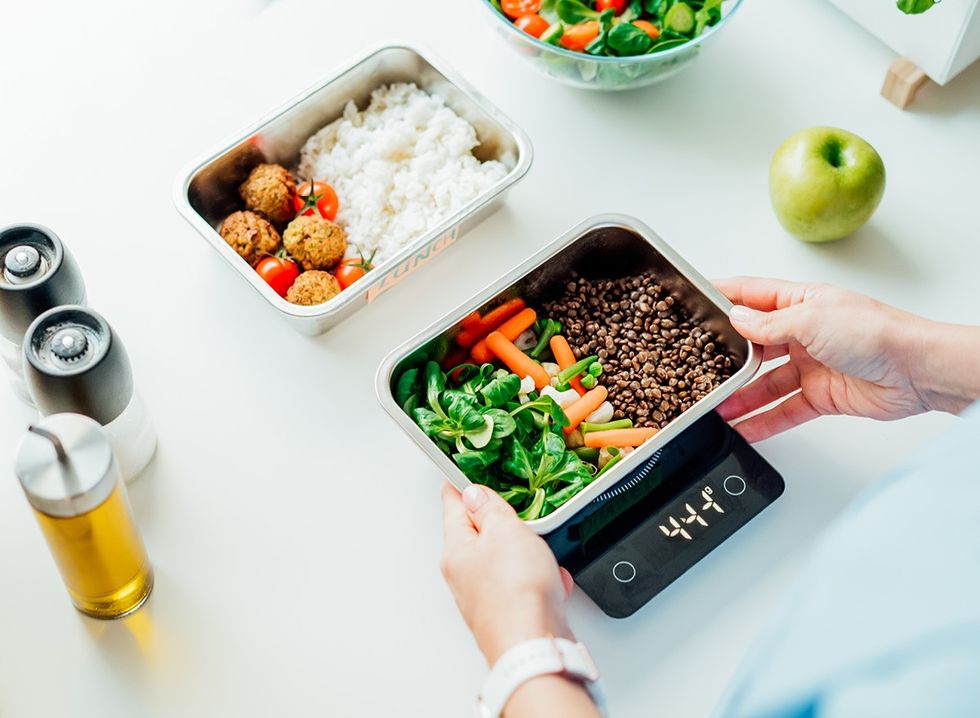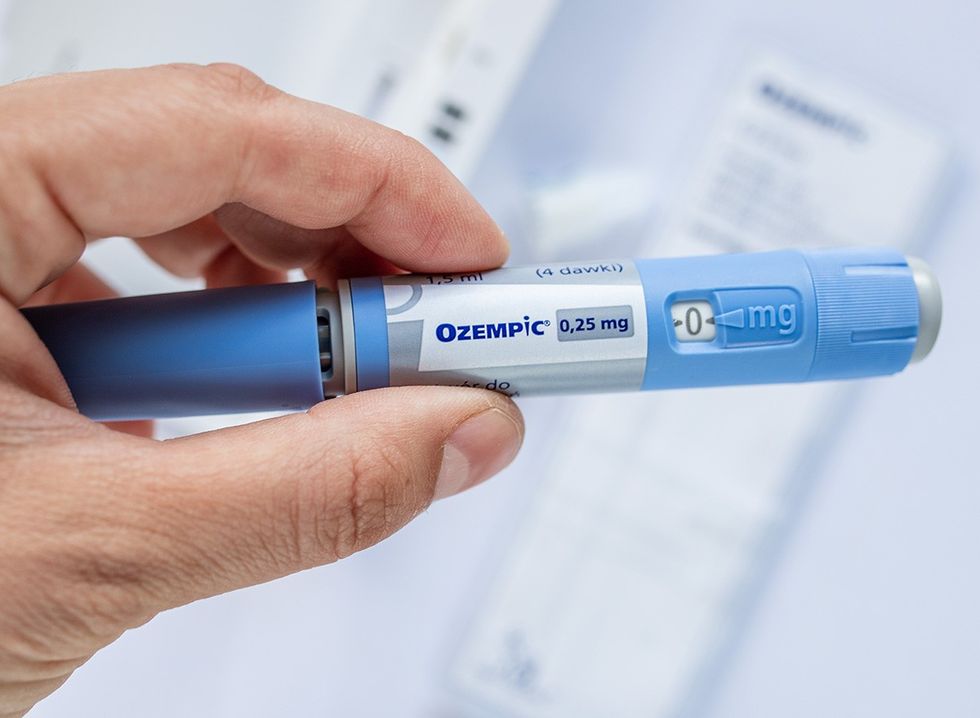Do you find yourself constantly battling hunger pangs while trying to lose weight? You're not alone. While Ozempic may be the latest trending weight loss medication, it comes with a hefty price tag and potential side effects. Health expert JJ Virgin, a triple-board certified nutrition specialist and four-time best-selling author, offers powerful natural alternatives that can help control cravings and shed weight more effortlessly. "Mother nature has given us powerful alternatives that can help control cravings and shed weight more effortlessly," says JJ. From protein-rich foods to simple lifestyle changes, these natural appetite suppressants could be the key to achieving your weight loss goals without prescription medications. We've organized these nine powerful options as a countdown, starting with nine and building up to JJ's top recommendation so you can discover which ones might work best for you.
RELATED: 15 Things to Know Before Requesting Ozempic for Weight Loss
9. Berberine: The Metabolic Master Switch
While often compared to GLP-1 medications, berberine works differently. "Berberine doesn't directly impact GLP-1," JJ clarifies. "Instead, it improves glucose metabolism and insulin sensitivity by activating AMP-activated protein kinase, or AMPK—the metabolic master switch."
For those looking to improve insulin sensitivity and blood sugar control, JJ recommends taking one to two berberine capsules before meals. This natural compound can help manage hunger by addressing one of its root causes: blood sugar dysregulation.
8. Apple Cider Vinegar: The Ancient Appetite Suppressor
Apple cider vinegar has stood the test of time as a weight management aid. "I currently work with someone who needs to lose 200 pounds, and I have them taking two tablespoons of apple cider vinegar every day," JJ shares. A randomized clinical trial published in the Journal of Functional Foods in 2018 showed that 15-30ml of apple cider vinegar daily, combined with caloric restriction, effectively reduced body weight, BMI, and appetite.
JJ recommends taking one to two tablespoons daily, especially before your largest meal or before consuming carbohydrate-rich foods. "It helps lower the blood sugar response to meals and may improve insulin sensitivity," she explains.
7. Exercise: The Anti-Hunger Activity
Exercise does more than burn calories—it directly impacts appetite hormones. "Exercise enhances the secretion of GLP-1 and helps regulate leptin and ghrelin, leading to reduced feelings of hunger," says JJ. It also provides an endorphin release that can help manage stress-related eating.
JJ references a 2022 paper in Nature that identified an "anti-hunger molecule" produced during intense exercise. "This combination of lactate and phenylalanine is responsible for about 25% of the anti-obesity effects of exercise," she explains. JJ recommends high-intensity interval training like the Norwegian 4x4 method, along with 8,000-12,000 steps daily and post-meal movement to manage blood sugar.
RELATED:20 Possible Ozempic Side Effects6. Calacurb: The Short-Acting GLP-1 Alternative
"The New Zealand government spent ten years and $30 million developing Calacurb, which acts like GLP-1 but is short-acting," says JJ. This bitter hops extract can significantly reduce hunger for a couple of hours, making it perfect for managing cravings between meals.
A 2019 randomized control trial published in Nutrients found that taking bitter hops extract during a 24-hour water-only fast significantly reduced hunger. "It stimulates GLP-1 secretion, helps with feelings of fullness, and improves blood sugar control," JJ explains. She takes two Calacurb capsules before each meal for optimal results.
5. Akkermansia: The GLP-1 Promoting Probiotic
"Akkermansia muciniphila is a probiotic strain that can promote the secretion of GLP-1," JJ explains. This is significant because many people with insulin resistance, fatty liver, or poor metabolic health have impaired GLP-1 secretion. By supporting natural GLP-1 production, Akkermansia helps regulate appetite and metabolic function.
Beyond appetite control, JJ notes that "Akkermansia improves gut barrier function, helping with leaky gut, lowering inflammation, and enhancing metabolic function while reducing fat storage." A 2019 randomized double-blind placebo-controlled study published in Nature Medicine showed improvements in insulin sensitivity and body weight with Akkermansia supplementation.
4. Allulose: The Rare Sugar with Appetite-Suppressing Powers
Allulose is a low-calorie sweetener that doesn't raise blood sugar. "It actually has the opposite effect," JJ reveals. "Taking 10-15 grams of allulose before eating can lower the blood sugar response to your meal." A 2022 study in the Nutrients Journal found that allulose suppresses hunger-associated feeding and inhibits hunger-promoting neurons.
JJ incorporates allulose into her daily routine through flavored syrups in morning coffee or smoothies. "I also enjoy Swelthy Snacks, which combine fiber, allulose, and dark chocolate—a perfect treat that helps control appetite," she shares.
RELATED:What Happens to Your Body When You Stop Taking Ozempic3. Water: Simple Yet Effective
"One of the easiest appetite suppressants is right at your fingertips: water," JJ states. Drinking water before meals helps you eat less and feel more full. Contrary to previous beliefs, JJ now recommends drinking water during meals as well. "Research shows water actually helps break down food, allows for better nutrient absorption, and slows digestion," she explains.
JJ suggests that many hunger signals are actually thirst in disguise. "We have an overactive hunger mechanism and an underactive thirst mechanism," she says. Try drinking a glass or two of water when you feel hungry, and you might find your cravings disappear.
2. Fiber: The Perfect Partner for Protein
Fiber works synergistically with protein to control appetite. According to JJ, "A 2022 review article published in Critical Reviews in Food Science and Nutrition showed how dietary fiber helps control appetite through multiple mechanisms." Fiber increases satiety, slows digestion, and helps maintain balanced blood sugar levels.
JJ recommends aiming for at least 30 grams of fiber daily, far more than the 5-14 grams the average American consumes. "I love berries for fiber—I try to eat two cups every day. Legumes and avocados are also excellent sources," she shares. If you're currently low on fiber, increase your intake gradually to avoid digestive discomfort.
RELATED:5 Foods That Maximize Weight Loss on GLP-1 Medicines, According to Coach1. Protein: Nature's Ultimate Appetite Controller
Protein stands as the foundation of natural appetite control. "When people consume at least 35 grams of protein, they feel less hungry and fuller for longer periods," JJ explains. A 2020 systematic review in Physiology & Behavior found that protein consumption reduces hunger, lowers ghrelin (the hunger hormone), and increases appetite-suppressing hormones like CCK and GLP-1.
Beyond satiety, protein offers metabolic benefits. "About 20-30% of protein calories are utilized during metabolism and muscle synthesis, compared to negligible amounts for fat and only 5-10% for carbohydrates," says JJ. This thermic effect means your body works harder to process protein, burning more calories in the process.
Implementing Your Natural Appetite Control Strategy
When adopting these natural appetite suppressants, JJ recommends a methodical approach. "Add one strategy at a time so you can connect the dots between what you're doing and how you're feeling," she advises. This allows you to identify which methods work best for your unique body and lifestyle.
Remember that weight loss isn't just about controlling appetite. "You don't lose weight to get healthy—you get healthy to lose weight," JJ emphasizes. By combining these natural appetite suppressants with proper nutrition and regular exercise, you can achieve sustainable weight loss without expensive medications or unwanted side effects. And if you enjoyed this article, take advantage of these 15 Quick Ways to Lose Body Fat Percentage in a Week.












 These Were Game ChangersShutterstock
These Were Game ChangersShutterstock Shutterstock
Shutterstock GLP-1s Signal to the Brain You Are FullShutterstock
GLP-1s Signal to the Brain You Are FullShutterstock
 Shutterstock
Shutterstock
 1. Yerba Mate: Your New Morning DrinkShutterstock
1. Yerba Mate: Your New Morning DrinkShutterstock
 Shutterstock
Shutterstock
 Shutterstock
Shutterstock Shutterstock
Shutterstock Shutterstock
Shutterstock Collagen ProteinShutterstock
Collagen ProteinShutterstock Shutterstock
Shutterstock What Happens to Your Body When You Stop Eating SnacksShutterstock
What Happens to Your Body When You Stop Eating SnacksShutterstock You Eat Out Too MuchShutterstock
You Eat Out Too MuchShutterstock

 12 Surefire Ways to Lose Abdominal Fat, Say ExpertsShutterstock
12 Surefire Ways to Lose Abdominal Fat, Say ExpertsShutterstock
 Not Being Obsessed with Fast ResultsShutterstock
Not Being Obsessed with Fast ResultsShutterstock Olive OilShutterstock
Olive OilShutterstock Shutterstock
Shutterstock 7. EggsShutterstock
7. EggsShutterstock TurmericShutterstock
TurmericShutterstock Natural Booster #4: BerberineShutterstock
Natural Booster #4: BerberineShutterstock Natural Booster #5: Gut-Supporting ProbioticsShutterstock
Natural Booster #5: Gut-Supporting ProbioticsShutterstock Digestive IssuesShutterstock
Digestive IssuesShutterstock Shutterstock
Shutterstock
 Shutterstock
Shutterstock Shutterstock
Shutterstock Shutterstock
Shutterstock Shutterstock
Shutterstock Shutterstock
Shutterstock
 Metabolic ImprovementsShutterstock
Metabolic ImprovementsShutterstock Breakfast Bowls: Berry Yogurt Power BowlShutterstock
Breakfast Bowls: Berry Yogurt Power BowlShutterstock Eating Too Little at a TimeShutterstock
Eating Too Little at a TimeShutterstock BerriesShutterstock
BerriesShutterstock CoffeeShutterstock
CoffeeShutterstock Choosing Salad Over SteakShutterstock
Choosing Salad Over SteakShutterstock Shutterstock
Shutterstock Fundamental 3: Prioritize Whole FoodsShutterstock
Fundamental 3: Prioritize Whole FoodsShutterstock It's Now Part Of My LifeShutterstock
It's Now Part Of My LifeShutterstock Natural Booster #7: Mediterranean DietShutterstock
Natural Booster #7: Mediterranean DietShutterstock Track MacrosShutterstock
Track MacrosShutterstock

 I'm a Nutritionist and These 9 High-Protein Snacks Keep My Clients Full While Losing 50 Pounds
I'm a Nutritionist and These 9 High-Protein Snacks Keep My Clients Full While Losing 50 Pounds
 Shutterstock
Shutterstock 2. Processed FoodsShutterstock
2. Processed FoodsShutterstock Shutterstock
Shutterstock Shutterstock/Prostock-studio
Shutterstock/Prostock-studio Shutterstock
Shutterstock Pro TipsShutterstock
Pro TipsShutterstock Shutterstock
Shutterstock Shutterstock
Shutterstock Shutterstock
Shutterstock Shutterstock
Shutterstock Don’t Drink as Much AlcoholShutterstock
Don’t Drink as Much AlcoholShutterstock Most Women on GLP-1s Are Making a Few Common MistakesShutterstock
Most Women on GLP-1s Are Making a Few Common MistakesShutterstock Soda and Sugary DrinksShutterstock
Soda and Sugary DrinksShutterstock Shutterstock
Shutterstock Eat BreakfastShutterstock
Eat BreakfastShutterstock And Improve Insulin SensitivityShutterstock
And Improve Insulin SensitivityShutterstock Belly Flab Strip Tip: Sugar and Fat Calories Leave Its Mark on Your BodyShutterstock
Belly Flab Strip Tip: Sugar and Fat Calories Leave Its Mark on Your BodyShutterstock Shutterstock
Shutterstock The Drugs Mimic the GLP-1 Hormone Naturally Produced by the BodyShutterstock
The Drugs Mimic the GLP-1 Hormone Naturally Produced by the BodyShutterstock 3. Deep-Fried ItemsShutterstock
3. Deep-Fried ItemsShutterstock